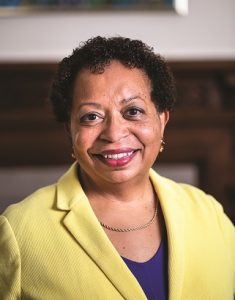Educating in a city, not an ivory tower, during a pandemic

Here at Trinity, we proudly tout that we provide students an excellent liberal arts education in a city, preparing them to navigate complex, real-world problems beyond our campus. Located in a capital city, we understand that real cities operate under real challenges and real constraints. We are not suburban and we are not rural, though we are close enough to drive to either in minutes; we are in and of Hartford, the city we call home.
The ability to navigate those real-world problems in a city has never been more evident than when reopening to in-person and remote instruction in fall 2020 during the pandemic.
Fall 2020 saw surges in COVID-19 cases in Connecticut and nationwide, particularly in early October and again in mid-November. On campus, we also saw surges in COVID-19 cases in early October, about one month after reopening. At one time, we had more than 50 active cases in a population of about 2,000 students and 300 employees who needed to work on campus. On October 10, our positivity rate was at its highest—1.2 percent, compared with 1.7 percent statewide.
During an uptick in cases, picked up by our aggressive testing protocols, we enacted best practices of contact tracing, isolating, and quarantining. We twice weekly tested students living on and off campus. For employees who were required to be on-site—many other employees worked effectively from home—we instituted weekly testing. This rigorous testing plan allowed us to identify outbreaks and to act swiftly to mitigate spread. With each outbreak, we reminded our community that safe practices need to apply in living situations and not just in classrooms. As a result, we brought active COVID-19 cases down to near zero in mid-October, even as cases around the state and country were increasing. By October 14, our positivity rate dropped to 0.3 percent.
When we ended our in-person semester on November 20, wisely choosing to stop on-campus instruction before Thanksgiving, we sent our students back to their homes with a COVID-19 test result in hand and a true sense of accomplishment. We had only 10 positive cases on campus, and our positivity rate was 0.48 percent for the last seven days of in-person classes, in contrast to the state’s rate of 5.8 percent, which was still one of the lowest in the nation.
How did we accomplish this? When walking around campus and virtually visiting classes during the semester, I saw evidence that almost all students were adhering to our practices of wearing masks and physical distancing; the few who did not faced consequences. When we saw upticks in the number of cases, we did not find that they were based on large numbers of students engaging in wild parties, as is often noted in media coverage of college life. Rather, these upticks seemed to stem from small-group interactions in which people (not just students) let their guard down around friends.
Our campus community took seriously its responsibility to one another and to our neighbors. In the heart of a city, we managed well amid a pandemic. Our students explored their academic passions with professors, engaged with coaches in physically distanced practices, and interacted with others in a host of virtual activities and internships. In other words, we continued to provide an excellent liberal arts education.
I am particularly proud of the community culture that we have built together. Several times, I remarked that members of our Trinity community both on and off campus, including our alumni, came together to support one another in extraordinary ways during the last several months. We recognized our common humanity; we were trying exceedingly hard to carry off the impossible—a somewhat normal semester—and we recognized the need to be a little more forgiving and a little kinder and gentler in the face of significant challenges. And it worked!
Here at Trinity, we can’t and don’t try to shelter students from complex, real-world problems. We simply cannot. We live in the real world, not in an ivory tower. We teach our students to address issues head-on, following best practices when we should and creating new practices when necessary. We learn to manage through crises, to show resilience, and to come out stronger on the other side.
I am proud that we successfully completed the in-person part of an unprecedented fall semester at Trinity. Our resilience, focus on mission, and care for ourselves and others in the face of adversity exemplify the true Bantam spirit.
